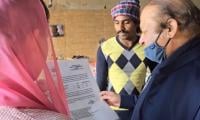As if the world doesn’t know already that sky is about to fall once again in Afghanistan, Prime Minister Imran Khan told his people through the Parliament that “very tough time” is coming for Pakistan - via Afghanistan.
Admitting defeat is ordinarily unpalatable for military commanders but in a press briefing for a select group of journalists, the US military head honcho in Afghanistan, General Austin Scott Miller admitted that “the security situation is not good right now… civil war is certainly a path that can be visualised if this continues on the trajectory it’s on right now. That should be a concern to the world.”
Taliban are gaining ground fast, capturing district after district. They also hold commanding position in Afghanistan’s three border crossings – with Tajikistan, Iran and Pakistan. Images of Afghan army officers and men coming to Taliban-designated “offices” to lay down arms and promise neutrality are going viral on the web. The security situation is definitely unnerving for western troops, already packed up to leave.
But what should Pakistan expect from the situation? For years, Islamabad was blamed by the US for being less than an honest partner in Afghanistan. Pakistan, the Washingtonians routinely said, wanted to hunt with the hounds without actually killing the hares. Pakistan had valid reasons – a Super Power can’t be trusted keeping the history of bilateral relations in focus. Simply put, Pakistan wasn’t ready to cull “friends” for “foes”.
So three cheers for the Prime Minister for telling the United States point-blank that Pakistan was ready to partner with Washington for peace but not war. He has numbers to tell how deadly the war in Afghanistan been for the state and society in Pakistan. In saying so, the Prime Minister revealed the pressure being applied on Islamabad by the West to change policy and posture in the region.
Former US Defense Secretary James Mattis made it clear in 2018 that India was US’ preferred partner in South and Southeast region. Speaking at the Shangri-La Dialogue in Singapore, Mattis even changed the name of the Asia Pacific region to Indo-Pacific region and told the world that the Quad – US, India, Japan & Australia – will not allow a single country [China] to hold sway in the Indian Ocean.
Pakistan is now being forced to make tough decisions – decisions that could force Pakistan into a diplomatic cul-de-sac. That’s why Prime Minister very right told the Chinese CGTN earlier this week: “It is very unfair for the US and other western powers to force countries like us to take sides. We should have good relations with everyone. It’s not going to happen that if pressure is put on Pakistan to change or downgrade its relationship with China. It won’t happen…. No matter what pressure is put on us, it is not going to happen.”
A cursory look at the last US attempt to flex it gargantuan military muscle would reveal beyond doubt that war in Afghanistan has been an utter failure for the sole Super Power. A detail read of the post-WW2 American military adventures would also expose that the US actually did not go into wars to win. The purpose was to kill and destroy, to shock and awe, to maim and murder. The longest war in American history might be painted as another war that is coming to an end. It may not end here. It may metamorphose into a conflict of a different nature that could continue for an indefinite period. Why would a defeated Super Power hand over a carte blanche to the emerging Super Power for its Belt and Road Initiative (BRI) or sideshows like the China Pakistan Economic Corridor (CPEC). Washington would like to keep Afghanistan boiling for as long as it could. Pakistan needs to be very careful about its future steps. Landmines are set and IEDs planted all over the place.
It would be educative to recall why US attacked Afghanistan and if it had achieved what it said it would achieve for itself and for Afghanistan.
a) The United States is keeping up with its long tradition of attacking and destroying a country and then retreating without a win. Naming the bombed and bruised countries is not essentially needed but it refreshes the record buried in thousands of book written all over the world - Korea and China (1950-53), Guatemala (1954, 1960), Indonesia (1958), Cuba (1959-61), Vietnam (1961-73), Laos (1964-73), Belgian Congo (1964), Dominican Republic (1965-66), Peru (1965), Guatemala (1967-1969), Cambodia (1969-1970), Nicaragua (1980s), El Salvador (1980s), Lebanon (1982-84), Grenada (1983), Lebanon/Syria (1983, 1984), Iran (1987), Panama (1989), Iraq (1991 & 2003), Kuwait (1991), Somalia (1992-94, 2007), Bosnia (1994-1995), Iran (1997), Sudan (1998), Afghanistan (199), Yugoslavia (1999), Afghanistan (2001-to date), Yemen (2002, 2009), Libya (1986, 2011). Pakistan’s bordering areas with Afghanistan were repeatedly targeted through drone attacks and the US ambassadors to Islamabad would avoid questions on the subject because Pakistan was a “front line ally” in the so-called War on Terror.
b) The so-called Afghan National Army – trained by the US and NATO countries – is collapsing like a sand castle. The seven military corps, based in Kabul, Gardez, Kandahar, Heart, Lashkar Gah, Mazar-i-Sharif and the north are largely on the run. Apparently, Taliban are too fearsome a spectre for the 180,000 strong army, enlisted and paid for by the western taxpayers for mere patrolling purposes.
c) The US-handpicked ‘popular’ presidents – Hamid Karzai & Ashraf Ghani – have miserably failed to throw a root in Afghanistan. Afghan government officials are still unable to leave the heavily fortified Green Zone in Kabul and travel to other cities and provinces to carry out essential governance tasks.
d) Multiple US military missions like the Operation Enduring Freedom or Resolute Force hardly won anything that would last beyond the US departure from Afghanistan. Gains, if any, are already turning into losses.
e) Cost of War Project report, published earlier this year claimed over $2 trillion was sunk in the war so far. “Most of the money came out of $933 billion in Department of Defense overseas contingency funding. The rest includes: $443 billion in DoD base budget increases to support the war; $296 billion to care for veterans; $59 billion in State [Department] overseas contingency funds; and $530 to cover the interest on the money borrowed to fund 20 years of deployments.”
f) Releasing the report, Neta Crawform, the Project’s lead researcher has said: “The DoD spending, at over $900 billion in Afghanistan, is the tip of the iceberg. The costs of the Afghanistan war include its escalation into Pakistan, millions of refugees and displaced persons, the toll in lives of combatants and non-combatants, and the need to care for America’s veterans.”
g) US have always described the human loss of life as “collateral damage”. Such crass classification of wanton killing of innocent humans leaves long-term adversarial impact. International estimates say that 241,000 people have been killed due to the war in Afghanistan, that includes more than 2,400 American service personnel and at least 71,344 civilians; 78,314 Afghan military and police; and 84,191 opposition fighters. These figures do not include deaths caused by disease, loss of access to food, water, infrastructure, and/or other indirect consequences of the war, the CWP said.
h) Pakistan has suffered dearly in the war that actually started in 1979 when the erstwhile Soviet Union marched into Afghanistan with “benign” intentions. With over 70,000 lives lost and billions of dollars evaporated due to battered economy, the country is bound to suffer long term damage that could only be rectified by international understanding, multilateral cooperation and by offering a helping hand.
i) The humiliating departure of the western forces will create an unreal sense of victory among the Taliban, who have fought this war with outside help. They might have provided thousands of men for the fighting, but an endless stream of material support did come from external sources. They must showcase humility as the next phase of war may just be around the corner.
j) As US packs up to leave Afghanistan, Washington is getting ready for the next global confrontation with China and its allies. Pakistan needs to be extra cautious. US is pressing Pakistan hard to provide bases from where it could fly missions into Afghanistan to kill the undefeated enemy – the Taliban. Pakistan should never agree to that.
k) Finding Pakistan uncompromising, the US could use bases in Oman or further afield to carry out operations in Afghanistan. Pakistan will have to think quick and hard if it would offer its air space as a corridor. Sense suggests Pakistan says no.
l) Pakistan should forget about its past “successes” to liaise between Washington and Beijing. Times were different, so were the ways the diplomacy was practiced. Its ineffective offering to play a mediator between Washington and Beijing is neither needed nor wanted any more. Pakistan must immediately stop it perennial habit of attempting to punch above it weight.
m) Pakistan’s civil and martial bureaucracy should realistically think of Pakistan first and the western demands second. Its future must be tied to regional actors like China, Iran, Turkey, Asean and CARs. But before that it need to put its own house in order. Islamabad must read the demands of Bretton Woods institutions and their affiliates with right glasses. A poor country with outsized ego can harm no one but itself.
n) Pakistani state must stop frightening and suppressing its own people. It won’t do any good any more. Rectifying the ruptured polity, making peace with angry element in erstwhile FATA and Balochistan has never been so important. Pakistan must stop offering openings to its naked enemies or actual enemies cloaked as friends.
Judge raised the query after warning to announce the verdict if Maneka’s lawyer remained absent from the hearing and...
The development came amid the United States’ explicit opposition to the bilateral project
Qaiser claimed that both parties rejected entire process which led to the formation of the incumbent government
She examined a proposed site for the construction of a state-of-the-art hospital in Murree and approved
Raoof Hasan warned against any attempt to extend the tenure of Chief Justice of Pakistan Qazi Faez Isa by another...
These payments will help PBA members to clear some of their liabilities







